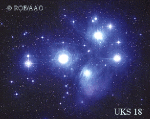
|
Astronomy Picture Of the Day (APOD)
 Bats And The Barren Moon
Bats And The Barren Moon
31.10.1998
This picture, taken as the Apollo 17 astronauts orbited the Moon in 1972, depicts the stark lunar surface around the Eratosthenes and Copernicus craters. Images of a Moon devoid of life are familiar to denizens of the space age.
 John Glenn: Discovery Launch
John Glenn: Discovery Launch
30.10.1998
At left, the Space Shuttle Discovery waits in darkness on Kennedy Space Center's launch pad 39B. At right, on Thursday October 29, Discovery blasts through a bright afternoon sky returning Senator John Glenn to space over 36 years after he became the first American in orbit.
 John Glenn: Friendship 7 To Discovery
John Glenn: Friendship 7 To Discovery
29.10.1998
Rehearsing for his historic flight on February 20, 1962, Mercury program astronaut John H. Glenn Jr. works in a cramped training capsule preparing for a few hours' voyage through space. Dubbed Friendship...
 NGC 6210: The Turtle in Space Planetary Nebula
NGC 6210: The Turtle in Space Planetary Nebula
28.10.1998
A Turtle in Space? Planetary nebula NGC 6210 may look like a giant space turtle, but it is actually much more massive and violent. Fortunately, this gas cloud in Hercules lies about 6500 light years away.
 Henrietta Leavitt Calibrates the Stars
Henrietta Leavitt Calibrates the Stars
27.10.1998
Humanity's understanding of the relative brightness and variability of stars was revolutionized by the work of Henrietta Swan Leavitt (1868-1921). Working at Harvard College Observatory, Leavitt precisely calibrated the photographic magnitudes of 47 stars to which all other stars could be compared.
 An Ion Drive for Deep Space 1
An Ion Drive for Deep Space 1
26.10.1998
Space travel entered the age of the ion drive Saturday with the launch of Deep Space 1, a NASA mission designed primarily to test new technologies. Deep Space 1 is bound for asteroid 1992 KD in July 1999.
 The Pleiades Star Cluster
The Pleiades Star Cluster
25.10.1998
It is the most famous star cluster on the sky. The Pleiades can be seen without binoculars from even the depths of a light-polluted city. Also known as the Seven Sisters and M45, the Pleiades is one of the brightest and closest open clusters.
 The Sun Also Rises
The Sun Also Rises
24.10.1998
Sunrise seen from low Earth orbit by the shuttle astronauts can be very dramatic indeed ( and the authors apologize to Hemingway for using his title!). In this breathtaking view, the Sun is just visible...
 Seyfert Galaxy NGC 7742
Seyfert Galaxy NGC 7742
23.10.1998
This might resemble a fried egg you've had for breakfast, but it's actually much larger. In fact, ringed by blue-tinted star forming regions and faintly visible spiral arms, the yolk-yellow center of this face-on spiral galaxy, NGC 7742, is about 3,000 light-years across.
 Jupiter: When Storms Collide
Jupiter: When Storms Collide
22.10.1998
Sometime in February, two of three long-lived Jovian storm systems known as "white ovals" apparently collided and merged -- forming what is now likely the second largest storm in the Solar System, after the famous Great Red Spot.
|
January February March April May June July August September October November December |
|||||||||||||||||||||||||||||||||||||||||||||||||